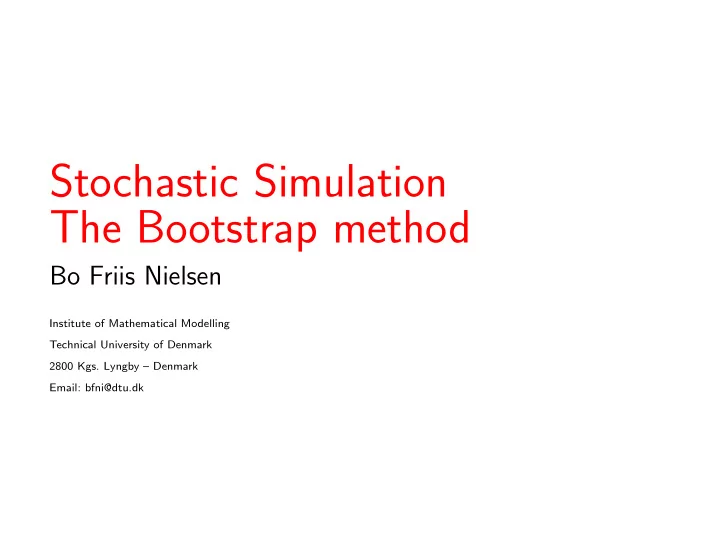

Stochastic Simulation The Bootstrap method Bo Friis Nielsen Institute of Mathematical Modelling Technical University of Denmark 2800 Kgs. Lyngby – Denmark Email: bfni@dtu.dk
The Bootstrap method The Bootstrap method • A technique for estimating the variance (etc) of an estimator. • Based on sampling from the empirical distribution. • Non-parametric technique DTU 02443 – lecture 10 2
Recall the simple situation Recall the simple situation • We have n observations x i , i = 1 , . . . , n . • If we want to estimate the mean value of the underlying x = � x i /n . distribution, we (typically) just use the estimator ¯ • This estimator has the variance 1 n Var ( X ) . To estimate this, we (typically) just use the sample variance. DTU 02443 – lecture 10 3
A not-so-simple-situation A not-so-simple-situation • Assume we want to estimate the median, rather than the mean. • (This makes much sense w.r.t. robustness) • The natural estimator for the median is the sample median. • But what is the variance of the estimator? DTU 02443 – lecture 10 4
The variance of the sample median The variance of the sample median If we had access to the “true” underlying distribution, we could 1. Simulate a number of data sets like the one we had. 2. For each simulated data set, compute the median. 3. Finally report the variance among these medians. We don’t have the true distribution. But we have the empirical distribution! DTU 02443 – lecture 10 5
Empirical distribution Empirical distribution 20 N (0 , 1) variates (sorted): -2.20, -1.68, -1.43, -0.77, -0.76, -0.12, 0.30, 0.39, 0.41, 0.44, 0.44, 0.71, 0.85, 0.87, 1.15, 1.37, 1.41, 1.81, 2.65, 3.69 DTU 02443 – lecture 10 6
Empirical distribution Empirical distribution X i iid random variables with F ( x ) = P ( X ≤ x ) Each leads to a (simple) random function F e,i ( x ) = 1 { X i ≤ x } � n � n leading to F e ( x ) = 1 i =1 F e,i ( x ) = 1 i =1 1 { X i ≤ x } n n � 1 � n � n � = 1 � � E ( F e ( x )) = E i =1 E = F ( x ) i =1 1 { X i ≤ x } 1 { X i ≤ x } n n Once we have sample x i , i = 1 , 2 , . . . , n we have a realised version of the empirical distribution function n n F e ( x ) = 1 F e,i ( x ) = 1 � � δ { x i ≤ x } n n i =1 i =1 where δ is Kroneckers delta-function DTU 02443 – lecture 10 7
The Bootstrap Algorithm for the variance of a The Bootstrap Algorithm for the variance of a parameter estimator parameter estimator • Given a data set with n observations. • Simulate r • (e.g., r = 100 ) • data sets, • each with n “observations” • sampled form the empirical distribution F e . • (To simulate such one data set, simply take n samples from the original data set with replacement) • For each simulated data set, estimate the parameter of interest (e.g., the median). This is a bootstrap replicate of the estimate. • Finally report the variance among the bootstrap replicates.
Advantages of the Bootstrap method Advantages of the Bootstrap method • Does not require the distribution in parametric form. • Easily implemented. • Applies also to estimators which cannot easily be analysed. • Generalizes e.g. to confidence intervals. DTU 02443 – lecture 10 9
Exercise 8 Exercise 8 1. Exercise 13 in Chapter 8 of Ross (P.152). 2. Exercise 15 in Chapter 8 of Ross (P.152). 3. Write a subroutine that takes as input a “data” vector of observed values, and which outputs the median as well as the bootstrap estimate of the variance of the median, based on r = 100 bootstrap replicates. Simulate N = 200 Pareto distributed random variates with β = 1 and k = 1 . 05 . (a) Compute the mean and the median (of the sample) (b) Make the bootstrap estimate of the variance of the sample mean. (c) Make the bootstrap estimate of the variance of the sample median. (d) Compare the precision of the estimated median with the precision of the estimated mean.
Recommend
More recommend